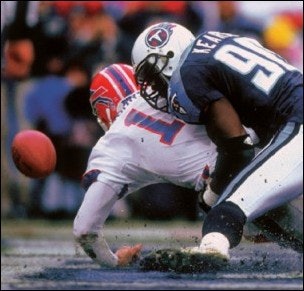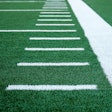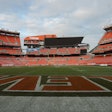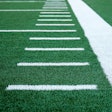The process of determining the forgiveness factor of athletic fields - both natural and synthetic - is packed with variables

The synthetic athletic fields at a small-city school district's two high schools were each closed for repairs and turf replacement this summer after their infill systems failed to meet the minimum shock-absorbency standards stated in the contract between manufacturer and buyer. The action marked the third time the surfaces underwent improvements since their installation in 1999.
Several series of tests determined that the fields' G-max rating, the numeric value indicating a surface's ability to absorb impact, exceeded the contract specifications of 105 Gs after 12 months and 110 Gs after 24 months. Testing in 2001 on both fields resulted in several sections with readings above 200 Gs - the threshold at which a surface must be repaired or replaced, according to ASTM International's standard F 1936, which covers the shock-absorbing properties of football fields in North America. As a result, this particular city's fields, amid much local furor, were closed indefinitely but reopened in time for the 2001-02 school year.
Looking back, those initial field specs seem "pretty soft," according to one leading agronomist. What's more, another expert notes, the average G-max rating for that type of field - using specific testing procedures outlined by ASTM International - is about 150 Gs. Yet, the lower specs were the ones agreed to by both parties.
This incident illustrates the kind of confusion that reigns these days in the synthetic turf marketplace, which is rife with contradictory claims about various types of infill systems, injury rates and other performance standards. Evaluating natural grass, too, can be a perplexing proposition, what with the numerous dynamics and factors that help determine a field's playability.
Organizations like the NFL and the NCAA have conducted studies comparing natural grass and synthetic turf (with the primary focus on injuries), and many synthetic-turf manufacturers have paid to have independent laboratories test their product samples and provide results. "But nobody has really given a Consumer Reports-type evaluation of these surfaces," says Tony Koski, extension turf specialist at Colorado State University, referring to the many synthetic products on the market featuring sand or rubber infill systems that claim to replicate the feel and play of natural grass. "That's why this topic has been so elusive."
(The U.S. Consumer Product Safety Commission has not issued any recommendations on synthetic turf. The watchdog organization, which has a hand in many sports-related issues, last addressed synthetic turf in 1976, when it denied a petition from the National Football League Players Association to develop a surface standard.)
Last month, however, Andrew McNitt, an assistant professor of soil science and turfgrass at Pennsylvania State University, began what he hopes will be an eight-year comparative analysis of 12 20-by-20-foot infill systems, installed outdoors at the university's turfgrass research facility. Not only will McNitt and his staff track shock-absorption characteristics under varying conditions using a machine that simulates football play, they will also evaluate other elements such as abrasiveness, traction, drainage and ball bounce, while potentially allowing manufacturers to make surface upgrades along the way, pending new product developments.
"I was getting a lot of questions about infill products, so I decided somebody should do the research," McNitt says. "There hasn't been a lot of information to go on. We don't know what happens over time. We hear all these different claims, but everybody's circumstances are different. So we'd like to get these infill systems side by side and see what happens. We'll let the numbers speak for themselves."
Given the rather rapid proliferation of infill systems in recent years - McNitt counts about 30 on the market today, with two-thirds of them based in the United States - many products were introduced without sufficient testing, some observers claim.
Initial results from McNitt's study won't be available for at least a year, but they will be published on a special web site McNitt plans to create - helping arm facility operators with better decision-making skills when it comes time to choose a synthetic field. "At the end, there will be no winner," McNitt says about his study. "One infill system might prove to work well for soccer, another for field hockey and another for a high school athletic director who wants low traction. It all depends on what you want."
Evaluating a field's shock-absorption characteristics is more than just determining whether it's hard or soft. And therein lies the source of so much confusion, contends Roger Schmidt, chairman of ASTM International's Committee F08 on Sports Equipment and Facilities. Comprised mainly of industry professionals (including manufacturers and users), that committee oversees the F 355 standard test method for shock-absorbing properties of both natural and synthetic turf, as well as the F 1702 standard method for measuring shock-absorption characteristics of natural turf. "Thinking that a field is soft just because it feels soft when you walk on it is misguided," Schmidt says. "The feeling you get when you walk across a field is different than it is when you fall 5 feet and land on it head first."
Hence, "hardness" and "shock absorption" are not interchangeable terms - another common misinterpretation, according to Schmidt. "Hardness" refers more to surface compaction of the soil or infill material, as well as comfort, which does not always equate to safety. Meanwhile, shock absorption, which is the dissipation of the impact's energy, correlates directly to injury prevention. The quicker the dissipation, the more shock-absorbent the surface. A field that's too shock-absorbent can lead to early leg-muscle fatigue, while a harder field can result in cartilage damage.
Keeping the distinctions between hardness and shock absorption in mind, how do researchers - or you, for that matter - determine whether a field will be forgiving enough when a wide receiver slams into it at the goal line? Decades ago, the task of doing so involved carrying more than 100 pounds of equipment to the test site, says Ed Milner, president of the International Association for Sports Surface Sciences, an organization of technical experts. "We chartered a DC-3 to haul equipment around," he says.
Today, the most common procedures employed in the United States involve performing a series of tests using either the equipment specified in F 355 or a Clegg impact soil tester, a method detailed in F 1702. Both involve a weighted missile, dropped from a specified height, that records how quickly the weight stops upon impact. Multiple drops are performed on the same section of turf to take into account the compaction that may occur from each drop and to ensure an accurate reading. The faster the weight stops, the harder the surface, which is measured as G-max.
Some history: Named after the late Baden Clegg, a professor at the University of Western Australia, the Clegg tester (also known as a hammer) is a portable device that consists of a hollow guide tube through which a flat-end cylindrical weight is dropped on a surface. The four weight variables are .5 kg (slightly more than 1 pound), 2.25 kg (almost 5 pounds), 4.5 kg (just less than 10 pounds) and 20 kg (44 pounds). In the United States, the most common weight used when testing athletic fields is 2.25 kg. When dropped from the specified height of 18 inches, the impact velocity is said to be similar to that created by an average-sized athlete falling on his or her elbow.
The impact of the hammer is translated to a digital display via an oscilloscope, which outputs a value - based on the peak deceleration of the hammer as it impacts the surface - in units of 10 Gs. (The Clegg can also be modified to indicate the nearest 1 G.) Clegg readings of anywhere between 60 and 95 Gs are generally regarded as acceptable, although - unlike the ASTM International-approved testing method - there is no specified maximum threshold calling for repair or replacement if Clegg-hammer test results exceed a specific G-max value.
John "Trey" Rogers, a professor of turfgrass science at Michigan State University, contends that many people who use the Clegg fail to take into account the duration of the hammer's impact, an "extremely critical" factor that is measured on the oscilloscope in milliseconds - about the length of time it takes to pound your right fist into your left palm. Typically, the shorter the duration time, the harder the surface is considered. "It's very easy to drop the hammer on two different surfaces and get the same G-max value, but the time it takes to complete that impact is different," Rogers says.
For example, when testing two natural-grass fields using the Clegg method, both may have a G-max value of 80, but the hammer might make contact with the surface for eight milliseconds on one field and for six milliseconds on the other. "The second field would be harder, because it returns energy to the body quicker," Rogers says.
Some industry professionals are skeptical of the Clegg tester - in part because it was initially used in the construction industry to test subsurfaces for roads and then adapted to sports surfaces in the 1980s. "It gives you a lower arithmetic number, so it sounds more attractive," Milner says. "But, unlike F 355, it's not analogous to a human head and neck banging into a surface."
Indeed, while the Clegg tester is portable and costs considerably less than the apparatus required for testing under F 355 - about $2,000 compared to about $20,000 - its results do not correlate with those from the F 355 test method. "It may be perceived that ASTM International doesn't want to use the Clegg and must have something against it," Schmidt says. "That certainly isn't the case. We'd like to use it - it's a lot cheaper. But the results cannot be correlated to F 355."
Like the Clegg test, the F 355 method also evolved from methodology used in other disciplines - namely, automobile-crash testing that determines how much acceleration the human body can absorb upon impact with a car's dashboard. Following F 355 procedures, a 20-pound, flat-end weighted missile - about equal to the weight of the average human head and neck, with the 20-square-inch surface area similar to that of an average human face - is dropped from a height of 2 feet. G-max values are then registered on a nearby laptop computer. This testing method can be used on both natural and synthetic surfaces.
As previously indicated, if a turf system tested following F 355 guidelines yields G-max values greater than 200, that surface needs to be repaired or replaced. To use a real-world example, Milner says that a player who takes a hit on a field testing at 200 Gs could experience up to six times more damage to his body than if the hit occurred on a field registering 100 Gs. While both the Clegg and F 355 methods measure physical properties, neither infer specifically how safe a field will be.
It's worth noting that other countries use different testing methods that provide results in a variety of measurements. For example, the Fédération Internationale de Football Association (FIFA), international soccer's governing body, last year introduced a field-testing procedure for synthetic turf that uses a weighted anvil and spring to express shock absorption in percentages. FIFA does not have test criteria for natural grass, however.
Facility operators wishing to monitor a field's shock-absorption characteristics can use either a Clegg tester or the F 355 method, according to Don Waddington, chairman of ASTM International's subcommittee on natural playing surfaces, which oversees standard F 1702. "Just don't switch," he says. "Pick one and stick with it."
Like surface testing methods, the surfaces themselves each have their share of supporters. But, as Suz Trusty, communications director for the Sports Turf Managers Association says, "Every field is going to have problems of some sort."
Because natural grass is a living and breathing entity, reams of research already prove that hardness characteristics are influenced by several variables - some beyond human control and others within our grasp. Soil and vegetative conditions, including soil type, thatch presence, core cultivation, amount of moisture and, in some cases, even mowing height, can affect impact attenuation. As everyone knows, for example, as soil water decreases, G-max values typically increase; hence, dryer fields usually are harder.
"I think a poor natural turf can certainly be more dangerous than synthetic turf because of the variability factor," says Mike DePew, chairman of the STMA's Technical Standards Committee. Most likely, so will a high-use natural field, which will experience greater and faster compaction than one composed of synthetic turf. While such perennial ryegrass mixes as Kentucky bluegrass or tall fescue are more compaction-tolerant, a good cultivation plan for any natural field will help avoid serious compaction issues and keep a field relatively shock-absorbent. The STMA suggests developing a cultivation program that adheres to proper soil moisture conditions for a field's particular species of grass, builds in time for hollow-tine aerating, limits use in an effort to promote turfgrass recovery and chemically controls weed and disease problems.
Sand and nitrogen amendments can also aid soil recovery. Even then, though, those amendments will react differently in different parts of the country because of the variety of soil conditions native to a particular region or climate. The dynamics of natural grass and its subsurfaces can result in uniformity issues, too - meaning that various sections of the same field, such as the area between a football field's hash marks or within a soccer field's goal box, may register significantly different G-max values because of compaction, usage and other factors.
Some issues impacting a natural field's ability to absorb shock, however, are beyond your control. Take weather, which plays a huge role in how hard or soft a field will test. Generally speaking, a wet, sloppy field tested under ASTM International's F 355 parameters will register at about 65 Gs, while a frozen field will likely register in the range of 185 to 225 Gs. For comparison's sake, a baked clay baseball or softball infield tests at about 200 Gs. "I can't think of many natural-turf fields that are going to be more than 200 Gs, unless they're baked, frozen or have rocks buried underneath them," Waddington says.
"There can always be logical explanations for why a natural field has a high G-max," adds Rogers.
Even though synthetic turf isn't living, the new generation of synthetic surfaces contains such elements as rubber granules, sand and elongated fibers that weren't features of synthetic turf's first generation of products. Some researchers believe static electricity can be created among the infill materials and potentially influence their migration, while others express concerns about effective moisture drainage and the collective impact of other substances seeping into the turf. Because the degree of shock absorption provided by the infill is dependent on the infill's ability to move, materials that might conceivably clog that movement could impair its effectiveness.
Perhaps these are concerns best addressed by the manufacturers themselves, who hope to do just that through the potential formation of an association comprised of manufacturers, materials suppliers and architects that will be overseen by an independent board of directors. Although the idea is still in its infancy, the association would interact with ASTM International to come up with standard criteria to determine whether a synthetic field is too hard or too soft, safe or unsafe.
McNitt, whose new Penn State study enables him to work closely with several manufacturers, has been involved in gauging industry interest in such a collective effort. "I think the formation of an association like that would do much to advance the industry and drive it in a more scientific direction," he says.
While athletic fields remain one of the turf industry's most consistent maintenance challenges, decades of research indicate that no two fields are the same. Each performs based on a number of distinct factors, many of which contribute to a field's shock-absorption characteristics. Says a local official close to the field-repair projects in the aforementioned small city, "This is what happened with our fields. For all we know, this product has worked fine elsewhere."




































